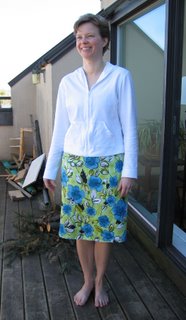Sewiknit Skirt Finished

Just in time for the deadline, I've finally finished my sew-along skirt. It's from McCalls 2029, view B. A few notes about some of the things I did:
Fit: it's been a while since I made anything, so I re-measured myself. I'm currently between a size 12 and 14. To get a better idea which size to cut out, I did a pin-fitting of the pattern peices. To do this I:
1. pinned out the darts
2. pinned the front and back pieces together approximately 5/8" in from the cutting line (i.e., on the seam line)
3. pinned the center front and center back to the yoga pants I was wearing (I often do this in my underwear, but for the sake of this demo went with close-fitting pants), positioning the waist (5/8" below the cut line) where I wanted it to sit when the skirt is finished.

Once the pattern was pinned to me, I checked the amount of ease at the waist and the hip. There was a comfortable amount of ease, but not too much. The size 14 seemed like a good choice.
I use weights for cutting out my patterns. I pin the pieces at each end of the grain line first, to make sure that's it's lined up corrected, then I use weights for the rest of the pattern piece. My weights are the largest washers I could find at the local hardware store. They are cheap, and only need a little buff to make sure they are clean before you use them for the first time.


For many years I was unhappy with my finished garments because the interfaced areas always seemed much stiffer than in storebought clothes, no matter how light the interfacing I used. I finally found fusible interlock interfacing, which is a very lightweight knit. I use it for about 85% of all my projects, from light cotton blouses to light wool jackets. It works for both woven and knit fabrics. In garments where I want a little more substance, I use a weft-insertion interfacing. This is a cross between a woven and a knit interfacing. For this skirt, I only used interfacing along the seam line of the zipper. This provides a little more stability and helps hold a crisp line for regular or invisible zippers.
One modification - I put facings on the waist instead of a waistband. Instead of the usual construction, I sewed the facings to the individual pieces so that my side seams are continuous - which makes it very easy to shrink or expand the skirt in the future by re-sewing the side seams.

